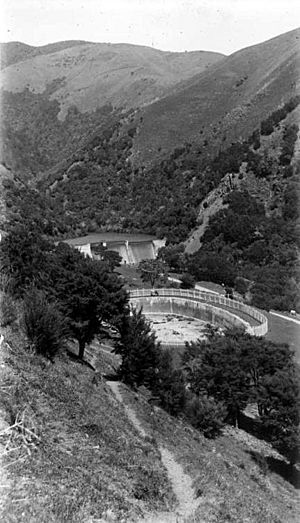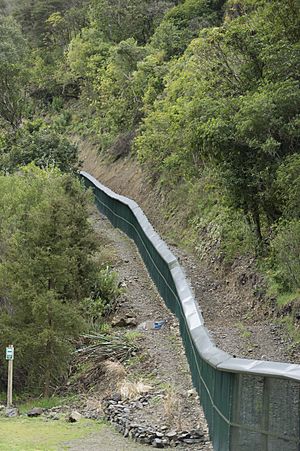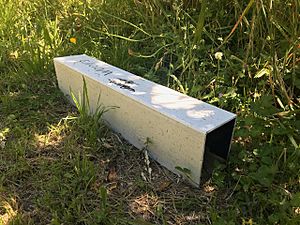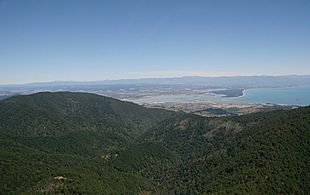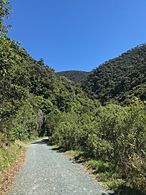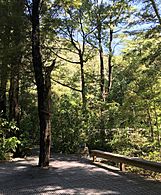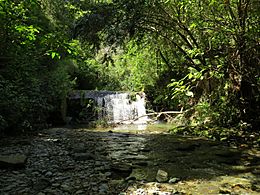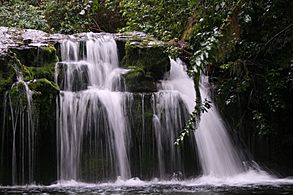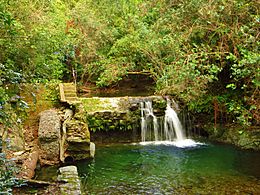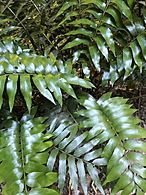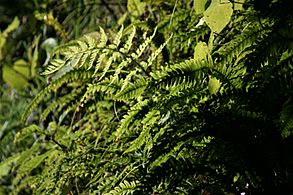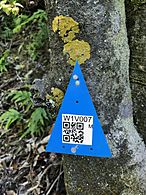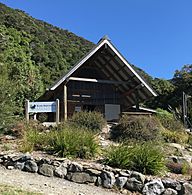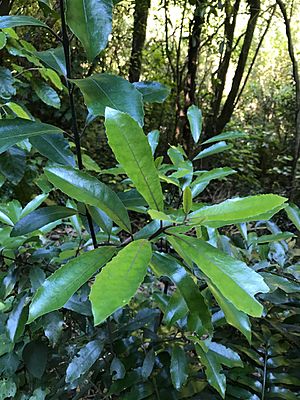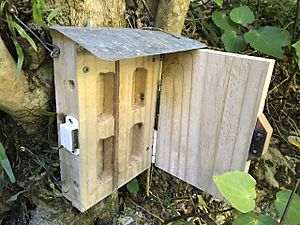Brook Waimārama Sanctuary facts for kids
Quick facts for kids Brook Waimārama Sanctuary |
|
|---|---|
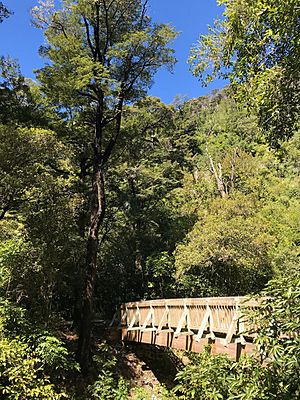
Bridge across the Brook Stream
|
|
| Location | New Zealand |
| Nearest city | Nelson |
| Area | 700 hectares (1,700 acres) |
| Elevation | 100 to 850 metres (330 to 2,790 ft) |
| Established | 2004 |
| Administered by | Brook Waimārama Sanctuary Trust |
| Open | Fri, Sat, Sun, 10am–4pm; Summer hours: 7 days, 9am–6pm |
| Habitats | Southern beech forest |
| Water | Brook Stream |
| Parking | At Visitor Centre |
| Public transit access | Route 4 to motor camp gate, 10 minute walk to Visitor Centre |
| Website | www.brooksanctuary.org.nz |
The Brook Waimārama Sanctuary is a special wildlife area near Nelson, New Zealand. It covers almost 700 hectares (about 1,700 acres). This sanctuary is like an "ecological island" on the mainland. It is surrounded by a special fence that keeps out pests.
The Brook Waimārama Sanctuary Trust started in 2004. Their goal is to bring back the native plants and animals of the Brook Valley. This valley used to supply water for Nelson. It has beautiful beech forests. A special fence was finished in 2016. After that, introduced pests were removed in 2017. The sanctuary then opened to the public in 2018. They plan to bring back rare birds like the Okarito kiwi and saddleback.
Contents
How the Sanctuary Started
The Brook Valley is just south of Nelson. For over 100 years, it was a water supply area for the city. The Nelson Waterworks Reserve was set up in 1865. It covered the area where the Brook Stream flowed.
Dams were built to hold water for the city. The first ones opened in 1868. More dams were added in the early 1900s. But the city needed more water as it grew. New water sources were found from the Roding River in 1941 and the Maitai River in 1987. This meant the Brook waterworks were no longer needed. They stopped being used in 2000.
The valley also had New Zealand's first railway line. It was a horse-drawn tramway built in the 1860s. It was used for a chromite mine. Later, coal mines also operated nearby.
People started planning to turn the Brook Valley into a wildlife sanctuary in 2001. The Brook Waimārama Sanctuary Trust was formed in 2004. The valley was perfect for a sanctuary. It was close to Nelson and next to the large Mount Richmond Forest Park. The upper parts of the valley still had their original beech forest.
In 2007 and 2008, the Nelson City Council and Tasman District Council gave money to start the project.
Building the Fence
A key part of the plan was building a special fence. This fence stops new pests from getting in after old ones are removed. This is called a "predator-proof fence." The plan for the fence was approved in 2009.
The area protected by the fence is very large. It is three times bigger than Zealandia, another famous sanctuary. The fence is also twice as long. It is the biggest wildlife sanctuary in the South Island and the second-largest in New Zealand.
The predator-proof fence was finished in September 2016. It took 12 years of planning and 18 months to build. The fence is 14.4 kilometres long. It cost $4.2 million. Money came from the Nelson City Council, Tasman District Council, donations, and a grant from the Lottery. The fence even has an electric wire. This wire detects if branches fall on it, which could let pests cross.
Removing Pests
A trapping program started in 2006. It aimed to control pests like possums, rats, mice, stoats, and weasels. Volunteers helped by cutting 22 kilometres of tracks. This allowed traps to be set up all over the valley. The traps were checked weekly. Shooters also removed about 100 goats that were damaging trees.
To remove all rodents inside the fence, bait was dropped from the air in 2017. Some people had concerns about this method. They worried about the poison being near waterways. However, after legal challenges, the courts allowed the sanctuary to continue with its plan.
After six months of checking, the sanctuary was declared "pest free" in 2018. At least 14 types of pests were removed. These included rats, stoats, and deer. The sanctuary now checks for rodents every four months. As of May 2019, only two rats had managed to get inside the fence. They were quickly removed.
The removal of pests had amazing results. In the year after, the number of tūī and bellbirds increased by 400 percent! Fantails and tomtits increased by 200 percent. There were also more ground invertebrates (like insects) and young tree seedlings.
Reopening the Sanctuary
The sanctuary welcomed visitors again on Sunday, 15 July 2018. It has an outdoor classroom for school groups. There is also a path that wheelchairs can use. Bridges cross over the old dam areas. The visitor centre has been open since 2007. A new wheelchair-friendly bridge was planned for February 2020. However, the sanctuary had to close for a short time due to a high fire risk in summer.
Gallery
How the Sanctuary is Managed
The Brook Waimārama Sanctuary Trust manages the sanctuary. Dave Butler was the chairperson from 2004 to 2019. He had been involved since the beginning. Chris Hawkes became the new chairperson in 2019.
Hudson Dodd was the first general manager. He started in 2012 and helped raise a lot of money for the fence and pest removal. Ru Collin became the new CEO in January 2019.
The Nelson City Council helps fund the sanctuary. They gave $250,000 for 2018–2019. They will give $150,000 each year for the next nine years. About one-third of the sanctuary's yearly budget comes from the Nelson City Council, the Department of Conservation, and Jasmine Social Investments. The rest comes from sponsors and donations.
In January 2020, the sanctuary changed its entry fee. Before, it was a suggested donation. Now, it costs $15 for adults and $8 for those under 15. A family ticket costs $40. These fees are half price for people who live in Nelson or Tasman, students, and those not working.
Plants of the Sanctuary
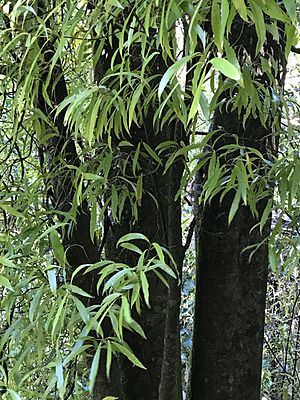
The Brook Waimārama Sanctuary is home to over 250 types of plants. This includes pukatea (Laurelia novae-zelandiae) and tawa (Beilschmiedia tawa). These trees are close to their southernmost natural range here.
About two-thirds of the valley has untouched Southern beech forest. All five types of beech trees grow here. You can also find mataī, rimu, and tōtara trees. The rest of the valley has a mix of kānuka, mānuka, and other regenerating broadleaf forests.
Rare Plants
- Red mistletoe (Peraxilla tetrapetala)
Uncommon Plants
- Forest parsley fern (Botrychium biforme)
- Gully tree fern (Alsophila cunninghami)
- Lace filmy fern (Hymenophyllum flexuosum)
- Notched glade fern (Hypolepsis distans)
- Green mistletoe (Ileostylus micranthus)
- Velvet fern (Lastreopsis velutina)
- Bamboo grass (Microlaena polynoda)
Animals of the Sanctuary
Many native birds are common in the sanctuary. These include tūī, bellbirds, fantails, kererū, grey warblers, brown creepers, silvereyes, and tomtits. South Island robins and riflemen are also moving into the valley bottom. These birds used to live only in the higher parts. Rare birds like New Zealand falcons/kārearea are also present.
The sanctuary plans to bring back several threatened bird species:
- Rowi or Okarito kiwi (Apteryx rowi)
- South Island saddleback / tīeke (Philesturnus carunculatus)
- Orange-fronted parakeet / kākāriki karaka (Cyanoramphus malherbi)
- Kākā (Nestor meridionalis)
- Yellowhead / mōhua (Mohoua ochrocephala)
In the stream, you can find freshwater crayfish (kōura) and koaro (Galaxias brevipinnis). Nelson green geckos (Naultinus stellatus) live in the sanctuary. The plan also includes bringing back tuatara. Among the insects, huhu beetles and tree wētā are easy to spot. Special "wētā hotels" have been set up along the walking tracks for them.



